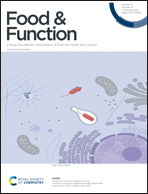Attenuation of allergenicity of roasted cod with Allium spp.: characterization of principal anti-allergenic constituent and action mechanism†
Abstract
Cod is rich in high-quality proteins and is a popular ingredient in many cuisines. However, it has also been a culprit in many seafood allergy cases. In the present study, the effect of pretreatment with Allium powders on the allergenicity and sensory profile of roasted cod was investigated. Enzyme-linked immunosorbent assay (ELISA) showed significantly reduced antibody-binding capacity of the Allium-pretreated samples compared with the control. The anti-allergenic effect was further confirmed with indirect ELISA using human sera. Moreover, the Allium pretreatments resulted in lower free sulfhydryl contents and higher surface hydrophobicity of the protein extracts prepared from the roasted cod samples, consistent with structural changes in favor of reduced allergenicity. Among the five Allium spp. evaluated, Chinese chive was the most effective, and mangiferin was identified to be a major anti-allergenic constituent. Docking simulation and mass spectrometry analyses revealed its strong parvalbumin-binding affinity and capability to reduce parvalbumin content in roasted cod, respectively. Finally, sensory evaluation indicated that the attenuation of allergenicity of roasted cod with the Allium spp. powders was accompanied by positive modulation of its flavor and taste profiles. These findings may provide insights for the development of dietary-phytochemical-based strategies for the management of parvalbumin-associated allergies.



 Please wait while we load your content...
Please wait while we load your content...